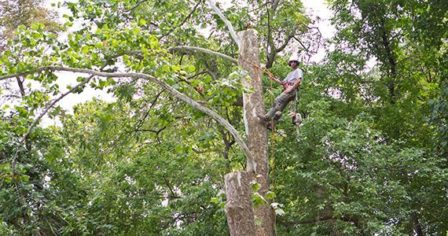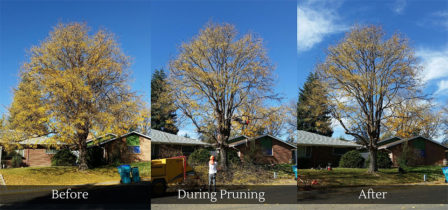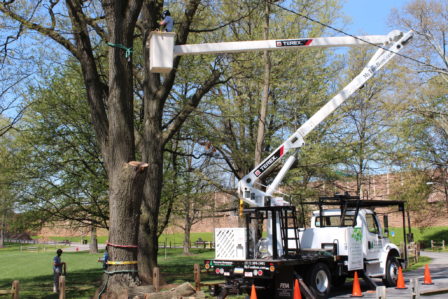This short blog focuses only on the importance of proper tree pruning related to price shopping. If you are interested in ‘topping’, ‘cutting back’, ‘shaping’ or having your tree removed for the ‘lowest price’ you can find, you should click to the next website now. Shopping alone for tree pruning is pointless.
If your interest lies in healthy, strong, productive, aesthetically-pleasing trees with generational longevity, read on.
Considerations
Many extenuating circumstances can affect the pricing for pruning or removing trees on an owner’s property. It is unfair to both the consumer and the contractor not to meet. You should discuss in detail the pruning project in question.
Trees are and should be considered ‘legacy plants’ in your landscape. It is common for well-maintained deciduous trees to live for over 100 years in an urban landscape. Certain evergreen trees may even live longer. The trees we plant and love today will be around for our great-grandchildren to enjoy, if we maintain them properly during our lifetimes.
Environmental factors, diseases, and insects can all affect a tree’s overall health. We can mitigate these influences only by proper plant selection, installation procedures and pruning practices.
When to call a Professional
 Weekend gardeners, enthusiasts and DIYer’s are encouraged to call on the professional when the pruning heights reach beyond a pole pruners capability. Tree pruning is intrinsically dangerous. A 2009 study done by the US Census for Fatal Occupational Injuries concluded that tree limbs falling in unexpected directions was the primary cause of injury in tree related accidents. Improper equipment coupled with dual and unsafe chainsaw usage are huge risks. These are compounded by a lack of general horticultural knowledge, which is a recipe for unhealthy trees. Also, let’s not minimize placing yourself at personal risk!
Weekend gardeners, enthusiasts and DIYer’s are encouraged to call on the professional when the pruning heights reach beyond a pole pruners capability. Tree pruning is intrinsically dangerous. A 2009 study done by the US Census for Fatal Occupational Injuries concluded that tree limbs falling in unexpected directions was the primary cause of injury in tree related accidents. Improper equipment coupled with dual and unsafe chainsaw usage are huge risks. These are compounded by a lack of general horticultural knowledge, which is a recipe for unhealthy trees. Also, let’s not minimize placing yourself at personal risk!
So, you’ve reached the point that your trees have outgrown your ‘green thumb’s’ reach, what’s next? First, you deserve credit for recognizing that fact. Also, caring enough about yourself and your trees to look toward professional assistance is laudable!
Who to call?
Arboriculture is “the cultivation, management and study of individual trees, shrubs, vines and other perennial woody plants. The science of Arboriculture studies how these plants grow and respond to cultural practices and to their environment.”
Reaching out to several Tree Care contractors to set-up and an onsite consultation is a great start. Companies affiliated with the International Society of Arboriculture (ISA) or the Tree Care Industry Association (TCIA) are a prudent first call. These companies are deeply invested in their staff’s education and training, as well as, the culture and science of arboriculture.
Often you are likely to be introduced to a Certified Arborist who represents the company. They will discuss your concerns and expectations regarding your proposed tree work. This individual often has years of experience in the field. They are also required to complete Continuing Education Units (CEU’s) annually to maintain their Arborist certification.
The Arborist or Account Manager should diligently listen to your concerns and expectations before conducting their own evaluation of the tree in question. The evaluation will focus on overall plant health, safety and risk factors, and necessary pruning requirements. Assuming the tree(s) pose no eminent danger to the public or any property, pruning and/or plant health care (PHC) recommendations will be made for the tree.
 The service
The service
Pruning is as much art as it is science. One of the nicest compliments an Arborist can receive after completing a pruning job is, “It doesn’t look like you did anything to the plant!”. A properly pruned plant should maintain the structure of its natural state while accomplishing the required outcome of the recommendations.
Arborists and tree care technicians use terms like – crown clean, crown thin, crown raise & reduce to direct pruning processes. Percentages and specific feet/inch instructions are given for each process to be performed on the given tree. A sample pruning spec for a tree may read something like this –
“Scarlet Oak (30” dbh), along right rear property line. Crown clean all dead wood > 1” dia., crown raise to 12-15’ above ground grade, crown thin 8-10%, clean-up & haul away all generated debris.”.
These instructions tell the pruning crew to look for the large Scarlet Oak tree in the back yard along the property line. They’ve been instructed to remove dead wood in the tree one-inch or greater. They will remove limbs of the tree that are within 12-15 feet of ground level. They’re also going to remove about eight-to-ten percent of the canopy to allow air flow. Finally, they’ll clean up the whole site.
While in the tree, Arborists will look for any dead, dying & diseased branches, any crossing or rubbing branches, and any weak or structurally poor branch attachments and remove or properly prune the structures.
Selecting a contractor
As an educated consumer of any skilled service trade or professional practice, it is apparent that price shopping and comparing “apples to apples” is a prudent fiscal responsibility before making a buying decision. Our “apples to apples” comparison begins with the consumer realizing they are not asking for their plants to become “geometric shapes.” Rather, a plant managed by a professionally-trained Arborist will ideally remain healthy and fruitful for decades.
As you select your service contractor, make sure they are properly licensed and insured. This is particularly important in the tree care industry. Review testimonials, references or even ask to see examples of completed projects. One factor that will affect pricing is the size and quantity of trees to be pruned. Another is the accessibility of the trees in relationship to the equipment needed for the project. Also, the duration of time between the last time the trees were pruned and even the distance the contractor must travel to complete the project are considerations.
If a tree is within the proximity of power lines, contacting the utility company is mandatory before beginning the project. Utility companies may complete some of the work at no charge to the customer if safety or potential power interruption is a threat due to the tree’s health or location.
Conclusion
We have touched on many of the extenuating circumstances that may affect tree pruning pricing. More importantly attempted to point out the significance of proper decision-making when the time rolls around to have your “legacy plants” managed with stewardship and thoughtfulness for our next generations to enjoy!
Please Contact Us today for a professional tree and plant health care consultation.
The post Shopping on Price Alone for Tree Pruning is Pointless appeared first on Tomlinson Bomberger.
from Tomlinson Bomberger https://ift.tt/2NYS2FU

No comments:
Post a Comment